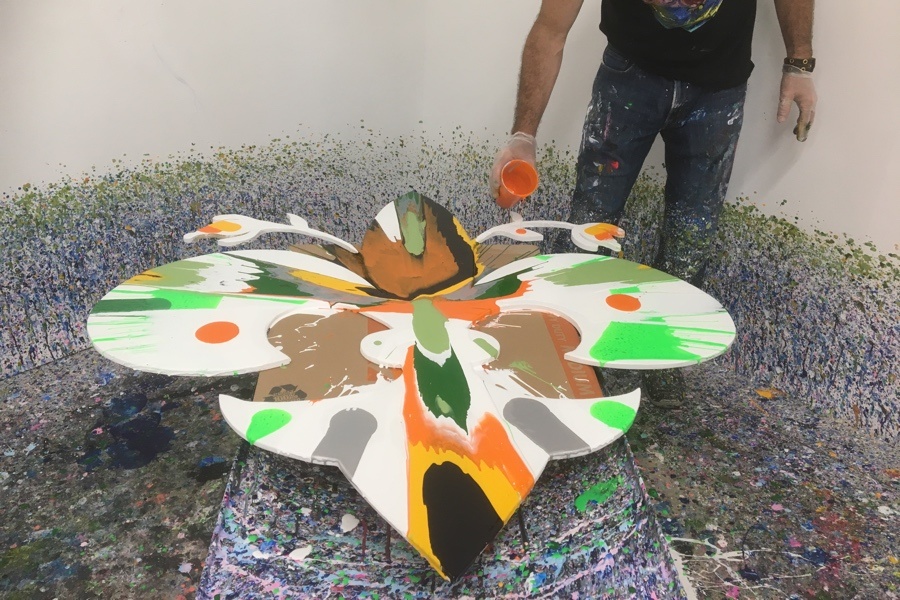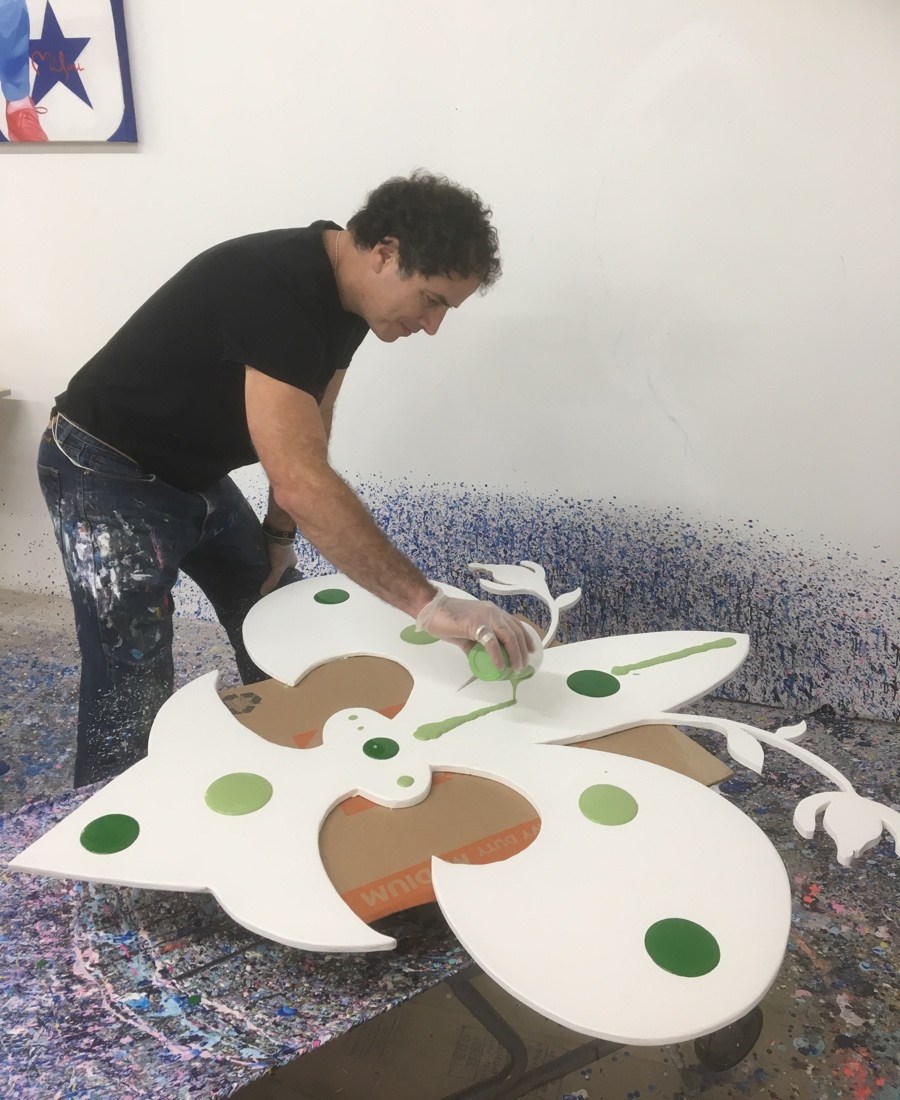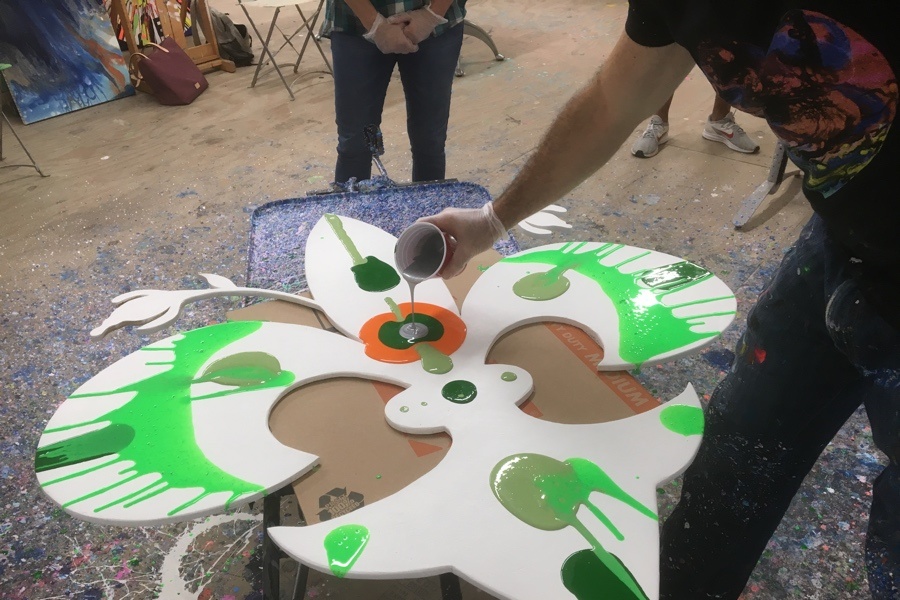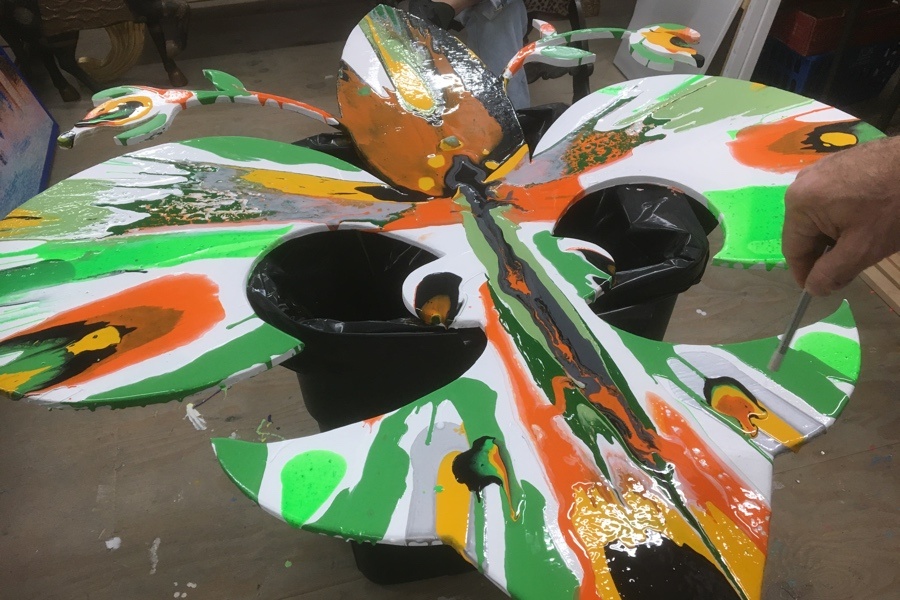What if Art Is the Best Way to Tell a Cancer Story?
As part of the Brushes With Cancer program, cancer survivor Janine Kirby partnered with pop artist Perry Milou to create a painting that speaks to her cancer journey.

Twist Out Cancer’s Brushes With Cancer program pairs cancer survivors and artists to tell cancer stories through an artistic lens. / Photograph by Mary Clare Fischer
On a side street in Bucks County, inside a refurbished textile mill, is a room full of color.
It’s because of the paintings all over Perry Milou’s Bristol art studio. They hang on the white walls, sit on the floor, nudge each other stacked in boxes. Categorized as pop art, the works draw on Andy Warhol’s frenetic vibrancy. But the faces that look out from the canvases — Nelson Mandela, Anthony Bourdain, Joel Embiid — are so realistic they trigger double takes.
But that’s only the surface level description, and art is always more than art. So, to metaphors: Really, the studio is a kaleidoscope, where bright shapes transform into other patterns and images depending on how you crook your neck. If you removed the ceiling and looked down into the room, it could be one of those glass, half-domed paperweights with streaks of shading and dimension shooting out from every corner in a mind-bending way that makes you reconsider whether what you’re looking at is real or just a trick of the light.
The room is a box of Crayola crayons, a bag of M&M’s, a tie-dye experiment gone right. It’s a scrapbook that never fades, a Mary Poppins bag that keeps on giving. It is wavelengths of pulsing energy.
And today, it will be a time machine, one that traces the history of a woman named Janine Kirby. Milou is creating a painting that represents Kirby’s cancer journey, as part of a program called Brushes With Cancer. Run by a Philly-based nonprofit called Twist Out Cancer, the initiative pairs artists with cancer survivors to tell their tales in mediums better suited to the inexplainable nature of, as oncologist and Pulitzer Prize–winning author Siddhartha Mukherjee calls it, the emperor of all maladies.
They’re using a strange-looking spinning device that resembles half a folding table with a Lazy Susan attached to the top and a handle on the end. Milou built it a few years ago as a painting tool for a series called “Spread Your Love.” He places pieces of heart-shaped wood on top, pours a pool of paint on them, and uses the crank to spin them, watching the colors whirl outward and create striking, unpredictable patterns.
“The whole concept is, we are really all just spiritual beings having a human experience,” explains Milou — lanky, with a mop of dark curls and paint-splattered jeans — as we sort through previous hearts. “Although we each have a physical beating heart that’s made from chemicals and vibrations and cells — I have a heart, you have a heart — your heart is different from mine, even though we’re all born from the same source of energy, whether you’re a Muslim, Jew, Christian, Hindu, whatever. And that’s the idea, to think about how we can share love and energy and vibrations.”
“When I pour these,” he continues, “as you can see, they’re so different. I could not possibly do the same thing twice.”
Today, though, Milou is painting a different shape: He’s carved a large fleur de lis, at least a foot long in each direction. “I was so excited when he said he wanted to do a fleur de lis,” Kirby says as Milou starts mixing up the paints. A redhead with the hardscrabble vibe that’s distinctly Philly, she looks eager but a little nervous. “It’s like my higher power symbol.”
“It’s her heart,” Milou says.
Kirby shows me her fleur de lis tattoos. She got one the first year she stayed sober and one the second year. In French, “fleur de lis” translates to “flower of the lily,” so she has lilies tattooed all over her back — one for every time she went to chemotherapy. “Lilies are a sign for hope,” Kirby says. “Hope is one of my biggest things.”
At least, ever since her cancer diagnosis: endometrial at age 24. It’s a disease that tends to show up in post-menopausal women, and it’s likely she wouldn’t have discovered it had she not gone to the doctor for a fertility test, in anticipation of having kids with her fiancé. “Thank god I did,” she says. “They were like, ‘The good news is, you can conceive a child. But you’re about to die.’”
Kirby was told she’d be lucky to make it to 30. Now she’s 44. She’s been through chemo and radiation and many surgeries, including getting part of her parathyroid removed as part of a secondary diagnosis. But she’s still here. “I’m always waiting for cancer to come back,” she says wistfully. “But it’s OK because I have a lot more tools now than I did before and a lot more people to lean on.”

Photograph courtesy of Mary Clare Fischer
We take a break from chatting because Milou wants Kirby to practice turning the handle on his contraption so she can help spin the painting. “I don’t know if the other artists that are participating with this are actually collaborating,” he says. “But I want it to be together.”
When she’s ready, he pours dots of light and dark green and stripes of lime in different spots on the fleur de lis.

Photograph by Mary Clare Fischer
As she turns the handle, the color blows toward the outer edges of the petals, with lines dripping down from the force of the movement. He pours more: a dark orange, a goldenrod yellow, black, and a sliver of gray. Some move more slowly than others, drifting out from the center of gravity like the tide lapping the sand. Some explode orgasmically, as if they’d been waiting for a nudge in the right spot to lose control.

Photograph by Mary Clare Fischer
As Milou takes over, Kirby points to different splotches on the painting. “Doesn’t this look like a unicorn?” she says. “Doesn’t this look like a butterfly?”
“That looks like a phoenix,” she says. “Like my tattoo.” She pulls up the sleeve of her teal blouse to show me yet more ink. (She has 17 tattoos in total.) This time, it’s a glorious, colorful bird — the one that’s said to be reborn from ashes. “It’s the first tattoo I got that I know I earned,” she says. “My friend Sal did it. He lost his best friend to cancer. It’s my most proud tattoo.”

Photograph by Mary Clare Fischer
Kirby turns back to the painting. Everywhere she looks, she sees more meaning. “That looks like a pumpkin ring,” she says. “I love the white. I love the negative space. I don’t know if anyone else noticed, but it looks very feminine part. It represents my cancer up there. That leaf is very female body part.” Then there’s the grey. “Life is so dramatic,” she says. “It’s 0 to 60, black or white, love or hate. No one appreciates how beautiful grey is.”
“It reminds me of one of those African feathers that the warriors wear with the way the color’s going,” she continues. “It looks very tribal, very erotic, organic. I use that verbiage a lot. Find your tribe, love them hard. Cancer survivors are all part of the same tribe, you know, just like fighters are all part of the same tribe. Survivors are all part of the same tribe.”
I ask her about the fighter reference. “When I was 14 years old, I started sneaking out of my house, like 14-year-olds do, to go work out at my uncle’s gym,” Kirby says. “I was an angry little kid. I was bullied growing up, the only girl of five, not that my brothers did it, but people were like, ‘Oh, let’s see how tough you are with four brothers.’”
She was lifting one day, and a man walked up to her and called her an “angry little thing.” Told her she had a lot of energy, that she was strong, but she needed some discipline. Her initial response was, “Fuck you, I don’t need shit.” But he won her over. Started teaching her how to punch, where to punch, how to hone her teenage angst. Eventually, it wasn’t about punching things anymore. It was about learning how to do a beautiful dance in a ring.
“I teach kids now out of my home,” Kirby says. “Two little girls that are having trouble at school. Not that they want to fight, but they do want to learn how to defend themselves. I already see a big difference in their confidence ‘cuz that’s what I try to teach them. You’re going to walk different when you know you can take care of yourself and thank God I had that confidence when I got diagnosed with cancer. I have always believed in myself, and boxing gave me that at a young age. It would come in very hard lessons, and I wouldn’t always listen to it, but that’s what we all do. We all go through these trials and tribulations. I’m just blessed to still be here…’Cuz I’m not done learning. I’m not done fighting.”
Milou is still spinning the fleur de lis around and around. His friend Tony, who’s been observing from a corner, tells him he needs to add this, tweak that. Kirby looks over at the painting again, wild with color now. “There’s one piece here that looks like my brain,” she says. “That yellow spot looks like my brain.”
Kirby didn’t have brain cancer. But that’s the point: The story is about more than just cancer. Just as Kirby was getting her life back, a steel beam fell on the side of her head while she was working in a warehouse cleaning up as Hazmat spill for her job. She thought she was yelling at her employees to get her out from under the beam but turns out she wasn’t actually talking. It took 20 minutes to get her out of the wreckage.
Kirby shows me a picture of her brain MRI and how much they removed and all the hardware she was left with: four plates (“Don’t they look like Christmas cookies?” she asks) and eight screws. After her injury, she suffered from a condition called dysprosody that affected her speech and how she conveyed her emotions. She used flash cards to associate different emotions with words or sensations to help her remember how to react, like “fluffy” for when she was happy. It turned her, she says, into an analogy whore.
When Kirby wanted to work out again after recovering from brain surgery, Howard Aaron was the only trainer who would coach her given her muscle weaknesses. Jenn Benn Shersher, the founder of Twist Out Cancer, was also a client of Aaron’s, and he introduced the two of them. They bonded over enduring cancer at a young age — Shersher was 29 when she was diagnosed with a rare form of lymphoma — and how helpful the arts could be as a healing mechanism for a community that has gone through unimaginable horrors.
“It’s a great organization to just sit and be able to look across the table from somebody and not have to talk and just be like, ‘I know what you’re going through,’” Kirby says. “Especially today. There’s not one person who isn’t affected somehow by cancer. There’s no more six degrees of Kevin Bacon. It’s six degrees of cancer.”
To her point, Milou is a brain tumor survivor, although his was benign. He and Kirby actually had the same neurosurgeon, M. Sean Grady, at Penn. Milou hopes to paint a portrait of him to give to Kirby or perhaps a picture of a brain painted in all different colors.
Kirby is quiet, pensive. I imagine she’s thinking about how her life has gone and all the people she’s met through this experience. When she speaks, there is fire in her voice. “The first couple years, I spent so much time making sure everyone else was OK with my cancer diagnosis, you know? It distracted me actually. It gave me purpose. Like, ‘Oh Mom, Dad, your only daughter has cancer, let me take care of you.’ Oh, my new fiancé, I have cancer, let me make sure you’re OK with it. Oh, I have this new job — let me make sure they’re OK with it. That when push came to shove, I never took care of myself.”
“And then I had a good three, four year break, and that’s when it hit me,” she says. “Like, ‘Oh my gosh, I just beat cancer. Wait, now what do I do?’ When I didn’t have anything to fight, I had to process what had just happened to me. Talking with other cancer survivors helps to process these things and articulate something I can’t explain myself. So the fact that another survivor can help me explain, that’s dece.”
She and Milou stand together over the finished fleur de lis.

Photograph by Mary Clare Fischer
Paint has covered the walls behind them, adding another layer of experience to the studio. “We did it,” he says. “This is awesome. I love it.”
“I love it, too,” Kirby says.
“It’s going to keep doing its thing for a while,” Milou says, “but I think it’s there. I like the white. I like the flowers. This looks very horrific here, almost like a face.”
“Yes, I can see that,” Kirby says. “I see a warrior screaming, though.”


